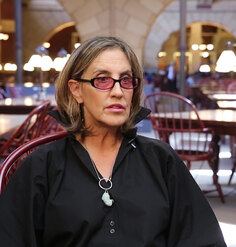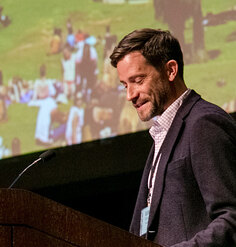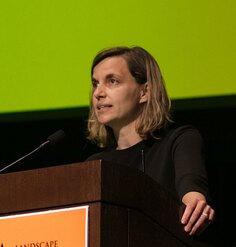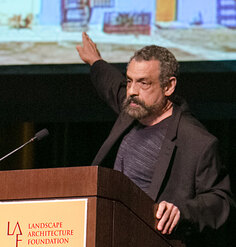The Declaration of Interdependence
By Randy Hester
This presentation was part of the Landscape Architecture Foundation’s The New Landscape Declaration: A Summit on Landscape Architecture and the Future held in Philadelphia on June 10-11, 2016. LAF asked a diverse group of leading minds to write a “Declaration” reflecting on the last half century and offering bold ideas for how landscape architecture can make its vital contribution in response to the challenges of our time.
Randy Hester
Director, Center for Ecological Democracy
Berkeley, Califonia
Randolph T. Hester is founder of the modern Participatory Design Movement in Landscape Architecture, professor emeritus at the University of California, Berkeley, and director of the Center for Ecological Democracy.
* Affiliation at the time of the Summit
The Declaration of Interdependence: Life, Liberty, and the Pursuit of Sustainable Happiness
by Randy Hester
Today and every day, we reaffirm our interdependence. We offer gratitude to those prophets who declared interdependence before us: from the ancients Isaiah and Buddha to Harriet Tubman, Rachel Carson, Stewart Udall, Grady Clay, and Karl Linn, among others. In their honor, we acknowledge our responsibility to make places for life, liberty, and the pursuit of sustainable happiness. We believe that this can only be attained in the foreseeable future through an ecological democracy, a participatory government driven by systemic ecological thinking. This ecological democracy has been in the making for 50 years, 250 years, and 250 million years, evolving in mutual dependence from sea slime to the landscape of humankind. We can see our choice as living happily within our limits or perishing as ecological illiterates. We choose to bend this evolution toward sustainable happiness by committing our every resource to the following actions.
Community. That land is a community is the basic principle of ecology. So it has been for eons. Today all humankind is tied together in a single garment of destiny; whatever affects one community directly affects all indirectly. We honor the prophecies of Aldo Leopold and Martin Luther King, Jr. We commit to enhance both ecological and cultural community as one indivisible unit through each of our design actions.
Transactive language. An ecological democracy demands a new civic language to elevate discourse, to allow citizens and designers to work together, and to enable the citizenry to make decisions informed by ecological science and native wisdom. This language will be as lofty as life-affirming symbiosis and civic duty, as provocative as proactive coastal retreat and living smaller, as explicit as the quarter-mile radius as the limit for pedestrian trips and the scare distance for birds at rest. We pledge to create this language.
Nature. The natural landscape speaks in ways older than words, telling us all we need to know to survive, filling us with every sensual pleasure we need to thrive. Nature is the door to ecological understanding, the former experienced, the latter abstracted into principles of proper action. Even those unconcerned about the crises we face love nature. Our skills are essential to create a broad-based constituency for dramatic ecological action. We will not stand silent to witness the last child in the woods. We will make nature accessible to every child in everyday life so that each one has an equal opportunity to be eaten by a mountain lion; to watch a swallowtail emerge from its chrysalis; to skip rocks on flat water; and to build imaginary cities from mud. Such experiences give birth to a constituency for ecological democracy.
Myths. Long-held American myths must be debunked. These include, but are not limited to: the legal misconception that corporations are people with the rights of individual citizens but with few of their responsibilities; that corporate money is entitled to buy and sell our democracy and destroy our environment; that land is foremost real estate, not a community; that beauty is an elite domain, defined by professionals—a status object to be sought by others; that the landscape is flat or safely made so; and that technology can solve everything. We commit to slaying these misconceptions and never contributing to them.
Capital. Virtual capital invested by the push of a single key on a laptop invariably maximizes short-term profits by disrupting ecosystems and cultures in distant places—out of sight, out of mind. Global economies consistently ignore the value of natural systems. We commit that we will not be party to this; rather, we will help develop place-based capital and work for place-devoted clients, responsible to the communities in which their capital is invested. This requires more long-term regional practice and fewer short-term consultancies spread thin around the world.
Just beauty. The landscape can never be more beautiful than it is just. We vow to make the world both beautiful and just simultaneously. We claim environmental justice as our cause, knowing full well the difficulties therein. We commit to equitable access and distribution of landscape resources—their costs, benefits, and joys. We will create places that welcome all segments of society, not just the privileged few. We will provide open space equally in every neighborhood. We will locate necessary but undesirable land uses fairly, regardless of race or class. We will map injustices in our communities, set strategies, and find partners to overcome the injustices.
Skills. The unique skills of landscape architects built the foundation for ecological democracy and are the basis on which we offer these transformative actions. Every imminent danger is an opportunity for our holistic creativity to advance a plan based on a logical ecological unit rather than a political boundary, to design with resources others view as worthless, to make places that touch people’s hearts. We will maximize seemingly mutually exclusive oppositions rather than compromise them. We will violate boundaries of discipline and scale. We will employ our expertise to act courageously on convictions. This requires our traditional skills, emerging transactive skills, and the capacity to achieve radical transformative landscapes never before imagined. We will enable the next generation with each of these skills.
Politics. Every design action is a political act. Whose politics will we style? We call for disassembling the politics in whose morass we are entangled and immobilized. We envision democracy grounded in the idiosyncrasies of local landscapes, expressing the most noble human values and distinctive ecological prognostications for each locality. Strong and visionary federal, regional, and neighborhood governance needs to subsume ineffective levels of government. We commit leadership in this overhaul. We will not tolerate the status quo. We will disobey unjust and ecologically unsound laws. We will envision, negotiate, facilitate, and provoke, each in necessary season.
These are landscape architects’ actions for interdependence. Through these, we enter a gate from which we lead our society along the pathway to life, liberty, and the pursuit of sustained happiness.











